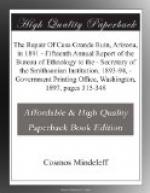Visiting tourists have done much damage by their vandalism. They have torn out and carried away every lintel and every particle of visible wood in the building. After the removal of the lintels a comparatively short time elapses before the falling in of the wall above. Apparently but a small amount of this damage can be attributed to rainstorms, which, although rare in this region, are sometimes violent. There is evidence that the present height of the walls is nearly the original height, in other words, that the loss from surface erosion in several centuries has been trifling, although numerous opinions to the contrary have been expressed by causal observers. The eastern wall has suffered more from this cause than the others; a belt on the northern half, apparently softer than the remainder of the wall, has been eaten away to a depth of nearly a foot. The interior wall faces are in good condition generally, except about openings and in places near the top.
Evidences of the original flooring are preserved in several of the rooms, especially in the north room. The flooring conformed to the pueblo type in the use of a series of principal beams, about 3 inches in diameter, above which was a secondary series smaller in size and placed quite close together, and above this again a layer of rushes with a coating of clay. All the walls show evidences of the principal series of beams in the line of holes formed by their ends where they were embedded in the walls. In the south wall, in parts of the east wall high up on the level of the upper roof, and in parts of other walls a few stumps of floor beams remained. These specimens of aboriginal woodwork have survived only because they are not in sight from the ground, and their existence therefore was not suspected by the tourists. Evidence of the other features of the floor construction can be seen on the walls in places where they have left an imprint, as described in the memoir previously cited.
No single opening remains intact, as the lintels have been removed from every one of them. This is particularly unfortunate, for openings at their best are an element of weakness in a wall, and here each opening, after the lintel was removed, became, as it were, a center of weakness from which the destruction of the wall mass gradually proceeded further and further.
PLANS FOR THE REPAIRS
The plans for the repair of the ruin and its preservation included the reservation of the area covered by remains and, if possible, its inclosure, for within that area are exhibited all the various degrees of decay and disintegration which clearly link the comparatively well preserved Casa Grande with the numerous almost obliterated ruins along the Gila and the Salt, whose vestiges will become even less distinct as time passes and cultivation increases.




